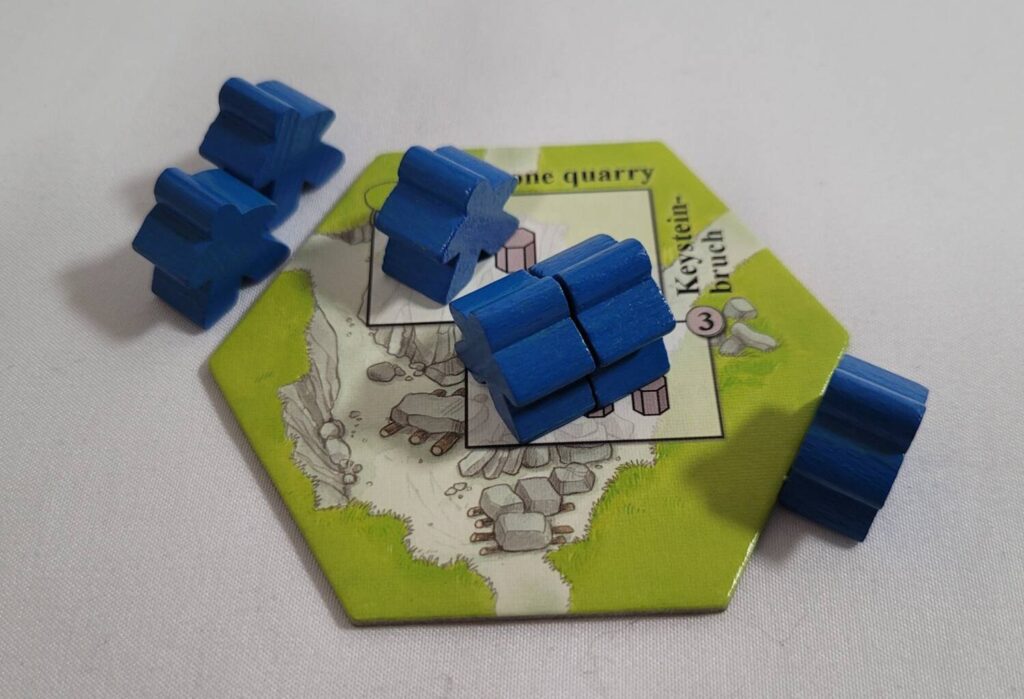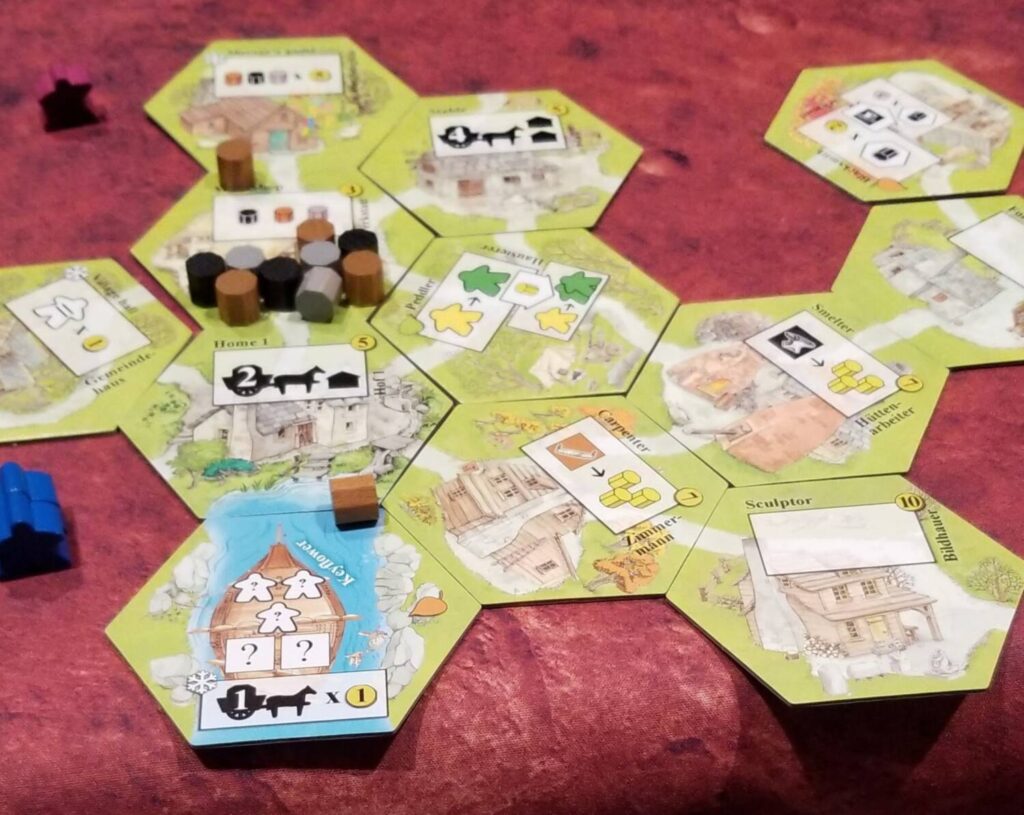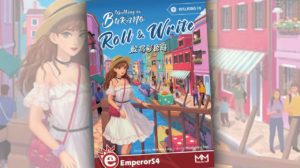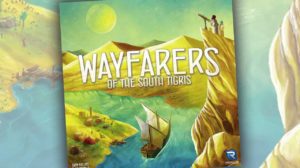The world is a small place, but it’s getting bigger every day. A new world has been discovered and brave colonists flock to its shores. It’s a rich land full of unclaimed resources and an abundance of nature. And for those who know where to look and how to see it, it’s an untapped fortune just waiting to be claimed. This is the world of Keyflower.
In the game of Keyflower, you are tasked with building a colony and populating it with colonists who will arrive on ships throughout the game. This is accomplished by a tile laying, worker placement, and auction mechanic that is unlike anything you have ever encountered in a game before. Yet at the same time somehow strangely familiar. The game takes place over a single year and is split up into four seasons. Each of these seasons will see new tiles to choose from which will, in turn, be used to build your colony. Auctions are won by bidding with your colonists, and new colonists will arrive at the end of each season to replace any that you might have lost. Do you have what it takes to come out on top? Do you possess the auctioning chops to outmaneuver your opponents on the auction block? Only time will tell.
If you’re already familiar with Keyflower and just want to know what I think, feel free to skip ahead to the Thoughts section. Otherwise, stick around as we talk about how the game is played.
Setup
Game Setup
First, all the meeples (sans the green ones) are placed into the cloth bag and the bag is given a good shake. Then, all the resource counters are separated by type and set off to the side. Next, all the skill tiles are placed face down onto the table and then shuffled to ensure they are mixed well.

Each player receives a random Home tile and a player screen, behind which you will hide eight meeples randomly drawn from the bag. All the other tiles should be sorted by season, shuffled, and placed into separate face down piles. Players receive a number of face down Winter tiles (determined by player count). These tiles will remain in the players’ possession for the remainder of the game and should never be shown to anyone else (although players may look at their own). A number of Boat tiles and Turn Order tiles will be set aside, again, based on player count. All other Boat and Turn Order tiles are returned to the box.
Round Setup
A game of Keyflower is divided into four rounds, one for each season of the year. Until the winter phase, the Boat tiles and Turn Order tiles will never be moved, but any other unclaimed tiles from previous seasons will be removed to make room for tiles from the new season. Boat tiles get filled with the requisite number of random meeples and skill tiles. Then additional tiles are drawn from the current season tile stack and placed into the central area, face up, with a couple of inches between each tile. The total number of new tiles to place is determined by player count. Not every tile for the current season will be used, ensuring that each game of Keyflower remains fresh with its own unique challenges and limitations. Once all this has been finished, a starting player is chosen and then you are ready for the new round.
Auctions and Actions
The key to mastering Keyflower is learning how to manage your meeples during the auction phase. Each tile in the game has six sides, and each side corresponds to one specific player. When a player decides that they’d like to bid on a tile that they would like to add to their village, they will choose a meeple from their supply and place it next to that tile. On their turns, other players may increase the bid by placing a higher number of meeples OF THE SAME COLOR on their side of the tile. This is because once a color has been played alongside a tile (or on top of, if using the tile’s action), then anything else that happens with that tile during the auction phase must use the same colored meeples. If a player is losing an auction, they have the option of moving all the meeples that are tied up in the losing auction as a group to another tile to either create a new bid or add to an existing bid (so long as they then become the winning bidder).
Instead of bidding on a tile, a player may use the tile for its ability by placing a meeple on top of the tile and taking the appropriate action. If there is already a meeple present on top of the tile or in a bid for the tile, then the meeple that is placed must be of the same color. If the action has already been used, then they must place at least one more meeple than was previously placed. Each tile can only accommodate six meeples on top of it. This means that, if you ever take the first action on a tile by placing three workers on it from the start, then no other player may take the action after you because they would have to place four workers on it to use it which would cause the tile to exceed the maximum allotted amount of six meeples. Also, not only can you use the actions from the tiles in the bidding area, but you can use tiles in your own village or other people’s villages in this same method.

At the end of the auction phase, each tile is considered, one by one. The winner of the tile has all the meeples that they spent to win the tile placed back into the bag. Any players that have meeples tied up in losing auctions for that tile will take their meeples back. Then, the winner will take the tile in question into their possession along with any meeples that may be on top of it from people using its action. Once every tile (with the exception of the Turn Order and Boat tiles) has been considered in this fashion, every player will simultaneously add the tiles they’ve won to their respective villages following placement rules I’ll let you explore when you play the game.
After this, the Turn Order tiles are considered in numeric order. The winner of the turn order tile will have their meeples placed into the bag while the losers will take their meeples back. Then, the winner chooses one of the Boat tiles and takes all the meeples and skill tiles from that boat, placing them behind their screen. The other players follow suit, in turn order, until all the Boat tiles are emptied. Then, the Turn Order tile bids are considered to determine the turn order for the next season.
The Tiles
The tiles in Keyflower can be loosely grouped into three categories: boat tiles, resource producing/moving tiles, and winter tiles. Without going into too much detail about what each and every tile does, let’s briefly discuss each of these categories and what makes them so different from one another.
Boat Tiles
There are two kinds of Boat tiles in this game. There are the boats that usher in new meeples at the beginning of each season and there are the Boat tiles that start being available in the summer. The main difference between these is that the summer boats provide you with long-lasting benefits while they are in your village, while the other boats are used primarily to usher in new colonists throughout the seasons. This second type of boats only become worth more at the end of the game during the winter season when they will provide valuable bonus victory points.
Boat tiles do not require you to place meeples upon them to make use of their innate abilities. Nor can you benefit from other players’ Boat tiles.
Resource Producing/Moving Tiles
These tiles are activated by placing meeples on top of them. Some will outright produce a resource of a certain type or a collection of resources, while others require some kind of tradeoff. This, for example, might be trading a skill tile for several stone resources or trading a red meeple for a green meeple. Anything produced from a resource producing tile is stored on top of the tile which produced it (or your Home tile if you produced using another player’s tiles).
Also listed on the front of these tiles is a cost associated with flipping the tile to its B-side. The B-sides of each of these tiles is a more powerful version of their A-side. And, for most of these tiles, having them successfully flipped to their B-sides at the end of the game is going to be where most of your victory points are going to come from.

In order to flip over a tile, the resources involved in paying the cost to flip it must be present on the tile in question. One cannot simply place resources on a tile, though. They must be moved there by some means and that is where the other type of tiles, the resource moving kind, come into play. Resource moving tiles are illustrated with a silhouette of a horse towing a wagon. On this wagon is a number that represents the total number of movements that a player may perform if they choose to take this action.
Also shown to the right of the horse and wagon is a silhouette of a house. The total number of houses shows how many “upgrade” actions (i.e., flipping a tile) may be taken along with the movement actions. Flipping these tiles means that, in the future, the resource moving tile will move resources more efficiently, be worth victory points, and allow for extra upgrade actions.
Now, let’s talk about the last type of tiles: the Winter tiles.
Winter Is Coming
At the beginning of the final season of the game, the winter, each player will select at least one of the winter tiles that they were given at the beginning of the game to be bid upon during the winter season. They are not required to throw in every winter tile that they were given, but any tiles not put up for bid are discarded. All the chosen tiles are placed face down onto the table and then shuffled so that nobody knows which tile belongs to whom. Once the tiles are shuffled, they are flipped face up. The other tiles that will be bid on in this phase are the Boat tiles and the Turn Order tiles. For ease of discussion, I will refer to the entire collection of tiles that are present for bidding during the winter season as Winter tiles.
Since there will be no more rounds beyond this one, none of the Winter tiles produces resources or allows players to move anything. Instead, what players are really bidding on are the bonus victory points that each Winter tile provides. There are too many bonuses to list here, but each one is described in detail in the back of the rule book.
The one rule that a player must keep in mind is that, if a meeple/skill tile/resource has been used once to score for one tile, then it cannot be used again during the scoring of another tile. For instance, if you would receive a bonus for each set of blue, red, and yellow meeples that you control and you have already used all your meeples in scoring for these sets, then you may not score for a tile that provides you a bonus for every yellow meeple that you control.
Once the winter phase is completed, players tally up their points to determine a winner. In addition to the points scored from Winter tiles, players also score the points displayed on all the tiles they have managed to flip over. Once everyone has added up all their victory points and bonuses, the player with the most points wins the game.
Thoughts
I’m not sure what I like the most about this game. It’s easy to set up (especially if you’ve taken the time to organize the tiles by season), it’s easy to teach, and it’s easy to put away. For all that ease of use, however, this game is very complex and extremely challenging.
The genius of the game is that the designers have turned the only luck-based factor—the meeple draw—into the main strategic element of the game. If you’re clever enough during the auction phases, then you can stock your village up with tiles that work well together or will lure your opponents into having to give their meeples over to you in order for them to achieve their aims.

While the auction portion of the game is arguably the most important part of the game, it’s only half the story. The other half is constructing a solid engine. You can win all the tiles in the world, but if you can’t turn them over, they are essentially worthless for end game scoring. The challenge comes in determining how best to spend your limited and random resources to the greatest effect. And, by limiting the game to only four seasons, the designers have ensured that the tension is ratcheted up. Building an efficient engine is only worthwhile as long as you have an opportunity to actually use it!
Keyflower is a beautiful game in every conceivable meaning of the word. The artistic aesthetic is phenomenal. The game design is flawless and elegant. Every decision that you make in this game is important. Nothing is wasted. And, the player interaction is off the charts! This is one of those games that, once you play it, you judge every game that comes after it against it. If you love board games and you don’t have a copy of Keyflower on your shelf, then you need to find a copy now!












